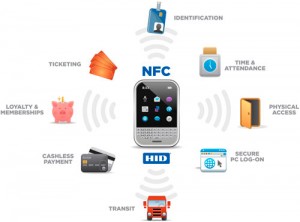 Global shipments of cellphones equipped with Near Field Communication (NFC) technology will surge by more than a factor of four from 2013 to 2018, reaching 1.2 billion units, according to IHS Technology (NYSE: IHS).
Global shipments of cellphones equipped with Near Field Communication (NFC) technology will surge by more than a factor of four from 2013 to 2018, reaching 1.2 billion units, according to IHS Technology (NYSE: IHS).
Last year sounded the starting gun for the fast growth of the market, with worldwide shipments of NFC-enabled cellphones climbing to 275 million units in 2013, up 128 percent from 120 million in 2012. The market will expand by more than 50 percent this year to reach 416 million, as presented in the attached figure. From 2013 through the end of 2018, worldwide shipments of NFC-enabled cellphones will rise by 325 percent.
NFC was integrated into just 18.2 percent of the 1.5 billion cellphones shipped worldwide in 2013. In 2018, NFC penetration will rise to 64 percent.
“The majority of smartphone makers are adopting the NFC wireless communications and payment technology in their products as a de facto standard,” said Don Tait, senior financial and ID market analyst at IHS. “Consumers are becoming increasingly aware of the benefits of mobile payment—and NFC wireless readers are proliferating in businesses throughout the world. This strong momentum will allow the NFC cellphone market to overcome barriers, including a lack of compelling services and applications, and the sluggish progress on establishing the required infrastructure.”
A major challenge for the NFC market in 2014 will be to develop services and applications that consumers want. This will help to promote mass appeal and adoption of the technology. The slow pace at which the mobile payment ecosystem is being rolled out is another key challenge that will need to be addressed this year.
NFC inside
NFC is a short-range, high-frequency wireless communication technology that allows cellphones to communicate with smartcards and readers, as well as with other NFC devices. NFC is used to perform safe, contactless transactions involving payment, public transportation or transfer of data.
While NFC was initially targeted at cellphones, the technology is increasingly being used in other devices such as tablets, sports and medical devices, gaming consoles, headsets and consumer white goods. An NFC modem is defined as an NFC IC with an antenna attached to it. This can also be termed an NFC modem front end (FE).
Invasion of the Androids
In 2013, Android-based smartphones dominated the NFC marketplace with 254 million units, or 93 percent, of all NFC-enabled cellphones shipped. In 2018, IHS predicts the number of Android NFC-enabled smartphones will reach 844 million, representing 75 percent of the NFC cellphone shipments.
IC solutions gain market share
Shipments of NFC modems in all kinds of devices—including smartphones—are expected to rise rapidly during the next five years. By 2018, all NFC modem-device-type shipments will grow to 1.64 billion, up from 321 million in 2013.
The most popular method of incorporating NFC into cellphones now is by embedding a standalone modem device directly into the handset. This method made up 90 percent, or 267 million, of all NFC modems that were shipped in handsets in 2013.
However, in the coming years, other implementations will become more popular, such as combination connectivity integrated circuits (ICs). IHS forecasts that shipments of combination connectivity ICs will increase to 603.0 million units by 2018, or 50 percent of all modems, up from 17.2 million units in 2013. The introduction of combination connectivity ICs has been slower to market over the last 12 months than first projected.






